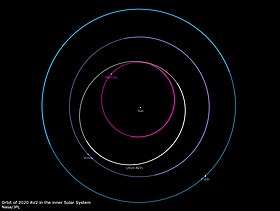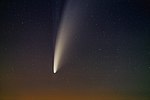2020 AV2
2020 AV2, also known by its internal designation ZTF09k5, is a near-Earth asteroid discovered by the Zwicky Transient Facility on 4 January 2020. It is the first asteroid discovered to have an orbit completely within Venus's orbit, and is thus the first and only known member of the intra-Venusian Vatira population of Atira-class asteroids.[8][9] 2020 AV2 has the smallest known aphelion and second-smallest known semi-major axis among all asteroids.[10] With an absolute magnitude around 16.4, the asteroid is expected to be larger than 1 km in diameter.[4]
 Long-exposure composite image of 2020 AV2 (center) | |||||||||
| Discovery [1] | |||||||||
|---|---|---|---|---|---|---|---|---|---|
| Discovered by | Bryce Bolin using Zwicky Transient Facility | ||||||||
| Discovery site | Palomar Obs. | ||||||||
| Discovery date | 4 January 2020 | ||||||||
| Designations | |||||||||
| 2020 AV2 | |||||||||
| ZTF09k5 | |||||||||
| Vatira[2] · Atira[3] · NEO[3] | |||||||||
| Orbital characteristics [3][4] | |||||||||
| Epoch 31 May 2020 (JD 2459000.5) | |||||||||
| Uncertainty parameter 7 | |||||||||
| Observation arc | 19 d | ||||||||
| Aphelion | 0.6538±0.0001 AU | ||||||||
| Perihelion | 0.4571±0.0002 AU | ||||||||
| 0.5554±0.0001 AU | |||||||||
| Eccentricity | 0.17708±0.00027 | ||||||||
| 0.41 yr (151.2 d) | |||||||||
| 222.490±0.092° | |||||||||
| 2° 22m 51.96s / day | |||||||||
| Inclination | 15.872±0.008° | ||||||||
| 6.707±0.004° | |||||||||
| 187.315±0.022° | |||||||||
| Earth MOID | 0.3461 AU | ||||||||
| Mercury MOID | 0.0656 AU | ||||||||
| Venus MOID | 0.0789 AU | ||||||||
| Physical characteristics | |||||||||
Mean diameter | 1.5+1.1 −0.6 km[5] | ||||||||
| 0.22 (assumed for S-type asteroids)[5] | |||||||||
| |||||||||
| Sa[5] | |||||||||
| 18.0[7] | |||||||||
| 16.4±0.775[3] | |||||||||
Discovery
2020 AV2 was discovered by the Zwicky Transient Facility (ZTF) survey at the Palomar Observatory on 4 January 2020, by astronomers Bryce Bolin, Frank Masci, and Quanzhi Ye.[1] The discovery formed part of a campaign for detecting interior-Earth asteroids (Atiras) using the wide-field ZTF camera on the 1.22-meter Samuel Oschin telescope at the Palomar Observatory.[11][9] The detection of such objects is difficult due to their close proximity to the Sun: asteroids within the orbit of Venus never reach solar elongations greater than 47 degrees, meaning that they are only observable during twilight as the Sun is below the Earth's horizon.[11] Because of this, intra-Venusian asteroids could only be observed within a short time frame, hence why the ZTF camera was used since it can effectively detect transient objects.[12]
At the time of discovery, 2020 AV2 was located in the constellation Aquarius,[lower-alpha 1] at an apparent magnitude around 18.[1] The discovery of 2020 AV2 was reported by astronomer Bryce Bolin, and was subsequently listed on the Minor Planet Center's near-Earth object confirmation page (NEOCP) on 4 January 2020.[12][9] Follow-up observations were then conducted at various observatories in order to determine the asteroid's orbit based on its orbital motion.[1][8] The discovery of the asteroid was then formally announced in a Minor Planet Electronic Circular issued by the MPC on 8 January 2020.[1]
Prior to the discovery of 2020 AV2, co-discoverer Quanzhi Ye and colleagues had predicted in December 2019 that the ZTF would detect its first Vatira asteroid within Venus's orbit shortly after the discoveries of several small-aphelion asteroids including 2019 AQ3 and 2019 LF6.[9] Given the difficulty of detecting such asteroids at small solar elongations, they estimated that at least one additional Vatira asteroid will be detected by the ZTF.[11]
Nomenclature
Upon discovery, the asteroid was given the internal designation ZTF09k5.[8] It was then given the provisional designation 2020 AV2 by the MPC on 8 January 2020, after follow up observations have sufficiently determined its orbit.[1] The provisional designation signifies the object's discovery date and year.[13] Due to its still short observation arc and uncertain orbit, the object has yet not been issued a minor planet number by the MPC. Once the orbit of 2020 AV2 has been sufficiently determined such that it will be given a minor planet number, it will be eligible for naming.[13] Being the prototype of the informally named Vatira class, it will be given a name that will be used to refer to this newly confirmed population.[2]
Orbit and classification

2020 AV2 is the only asteroid known to have an orbit completely within Venus's orbit. With an aphelion distance of approximately 0.654 astronomical units (AU),[3] it has the smallest known aphelion of all asteroids. In comparison, Venus's average orbital distance from the Sun is 0.723 AU, with a perihelion distance of 0.718 AU.[2] 2020 AV2 is formally classified as an Atira asteroid by the Minor Planet Center due it having an orbit within that of Earth.[3] However, unlike previously known Atira asteroids, 2020 AV2's orbit is contained within that of Venus, thus it falls into the proposed category of Vatira asteroids—a subclass of Atira asteroids with aphelion distances less than Venus's perihelion distance (hence the name: a portmanteau of 'Venus' and 'Atira').[2][11] 2020 AV2 is technically classified as a near-Earth object under the Atira classification, though the asteroid's minimum orbit intersection distance from Earth is 0.346 AU.[3]
Due to the short observation arc of 2020 AV2, its orbit has significant uncertainty, with an uncertainty parameter of 7.[3][4] The asteroid orbits the Sun in approximately 151 days (0.41 years), with a semi-major axis of approximately 0.5554 AU.[4] 2020 AV2's orbit is close to a 3:2 mean-motion orbital resonance with Venus, meaning that 2020 AV2 completes approximately three orbits for every two orbits completed by Venus.[14] The orbit of 2020 AV2 is moderately eccentric, as it approaches only 0.458 AU from the Sun at perihelion, just within Mercury's aphelion distance of 0.467 AU.[3] 2020 AV2's orbit is also moderately inclined to the ecliptic by approximately 15.86 degrees.[3][9] 2020 AV2 has a smaller orbital eccentricity and inclination compared to the generally expected values for typical Vatira asteroids, which were predicted to have an eccentricity around 0.4 and an inclination around 25 degrees.[14] The asteroid's minimum orbit intersection distance from Mercury and Venus is about 0.066 AU (9.9×106 km) and 0.079 AU (11.8×106 km), respectively.[4]
2020 AV2 is approximately tied with 2019 LF6 (0.5553 AU) as having the smallest known orbital period and semi-major axis among all asteroids,[8] though 2019 LF6 likely has a slightly smaller semi-major axis.[10][lower-alpha 2] In this case, 2020 AV2 has the second-smallest known semi-major axis among all asteroids. Despite this, when 2020 AV2 was announced, it was initially reported to have the smallest semi-major axis among the known asteroids before its orbit was refined.[1]
Orbital dynamics
2020 AV2 had likely originated from the main asteroid belt, where its orbit was locked in a secular resonance that caused its orbital eccentricity to gradually increase over time, evolving onto an Earth-crossing orbit. Subsequent close encounters with Earth, Venus, and Mercury resulted in gravitational perturbations of the asteroid's orbit, reducing its momentum and causing it to orbit closer to the Sun.[14] Such inward orbital migration of objects is thought to be rare.[12] Near-Earth asteroids transitioning into the Vatira region often have unstable, short-term orbits due to frequent gravitational perturbations by Venus and Mercury.[2] 2020 AV2 rarely crosses the orbits of Mercury and Venus, which reduces the number of close encounters with either planet that would otherwise perturb 2020 AV2's orbit. Nevertheless its orbit is likely to be stable for less than a million years, unless it is on (or enters soon) a nearby 3:2 mean-motion resonance with Venus, which could extend its stability to a few million years.[14][15]
Dynamical modeling of 2020 AV2's orbit show that the mostly likely scenario for its orbital evolution is that 2020 AV2's orbit will oscillate for several millions of years before gravitational perturbations lead to the asteroid's eventual collision with a planet, most likely Venus. At 140 thousand years from the present, 2020 AV2's aphelion distance will exceed Venus's perihelion distance, as a result of the combined effects of the Kozai resonance and gravitational perturbations. Within the Vatira region, the Kozai resonance causes the orbital inclinations and eccentricities of asteroids to oscillate over several millions of years. As a result, Vatira asteroids can become Atira-class asteroids and vice versa over time, and can cross the orbits of Mercury and Venus during these orbital oscillations.[16][14] The Kozai resonance often disrupts the orbits of Vatira asteroids, albeit it can also lead to orbital stability for some unperturbed Vatira asteroids.[17] At about 1.2 million years from the present, 2020 AV2 will leave the Vatira region and will transition onto a Mercury-crossing orbit, with its perihelion oscillating around Mercury's aphelion distance before decoupling from the planet's orbit at about 2.1 million years.[14]
After decoupling from Mercury's orbit, 2020 AV2 was shown to oscillate between an Atira-type orbit (Q < 0.983 AU) and an Earth-crossing Aten-type orbit (Q > 0.983 AU), in which the asteroid's aphelion oscillates around Earth's perihelion distance of 0.983 AU. About 740 thousand years afterward, 2020 AV2 will likely return to its Mercury-crossing orbit, though gravitational perturbations by Mercury and Venus will scatter it onto an Earth-crossing orbit once more before colliding with either planet. At about 4.1 million years from the present, 2020 AV2 will most likely collide with Venus.[14]
Physical characteristics
2020 AV2 is estimated to have an absolute magnitude (H) around 16.4, though this estimate has a large uncertainty.[3] The diameter of 2020 AV2 is expected to be larger than 1 km (0.62 mi).[4] Assuming that the albedo is between 0.25 and 0.05, its diameter should be around 1–3 km, respectively.[18]
Visible and near-infrared spectroscopy by the Roque de los Muchachos Observatory in 2020 suggests that 2020 AV2 is olivine-rich, based on the presence of a 1 μm absorption feature characteristic of S-type asteroids.[5] The absorption features in 2020 AV2's spectrum appear to be intermediate between the S-type and A-type spectral classes, hence it is classified as an Sa-type asteroid.[5] Assuming an average albedo of 0.22 for S-type asteroids, 2020 AV2's diameter can be constrained to approximately 1.5 km (0.93 mi).[5]
See also
- Vulcanoids – a hypothetical population of asteroids within Mercury's orbit
- 2019 AQ3, a dynamically-changing Atira asteroid that may have once been a Vatira asteroid[17]
- (524522) 2002 VE68, a temporary quasi-satellite of Venus
- 2013 ND15, the first known Venus trojan
Notes
- The celestial coordinates of 2020 AV2 at the time of discovery are 21h 24m 49.90s and −06° 08′ 41.8″.[1] See Aquarius for constellation coordinates.
- The orbits of 2020 AV2 and 2019 LF6 both have significant uncertainties, though the JPL Small-Body Database lists 2019 LF6 to have the smallest semi-major axis among all known asteroids.[10]
References
- Bolin, B.; et al. (8 January 2020). "MPEC 2020-A99 : 2020 AV2". Minor Planet Electronic Circular. Minor Planet Center. Archived from the original on 11 January 2020. Retrieved 9 January 2020.
- Greenstreet, Sarah; Ngo, Henry; Gladman, Brett (January 2012). "The orbital distribution of Near-Earth Objects inside Earth's orbit" (PDF). Icarus. 217 (1): 355–366. Bibcode:2012Icar..217..355G. doi:10.1016/j.icarus.2011.11.010. hdl:2429/37251. Archived (PDF) from the original on 29 May 2019. Retrieved 11 January 2020.
We have provisionally named objects with 0.307 < Q < 0.718 AU Vatiras, because they are Atiras which are decoupled from Venus. Provisional because it will be abandoned once the first discovered member of this class will be named.
- "JPL Small-Body Database Browser: 2020 AV2" (2020-01-23 last obs.). Jet Propulsion Laboratory. Archived from the original on 11 January 2020. Retrieved 9 January 2020.
- "2020 AV2". Minor Planet Center. International Astronomical Union. Retrieved 10 January 2020.
- Popescu, M.; de León, J.; de la Fuente Marcos, C.; Vaduvescu, O.; de la Fuente Marcos, R.; Licandro, J.; Pinter, V.; Zamora, O.; Fariña, C.; Curelaru, L. (11 August 2020). "Physical characterization of 2020 AV2, the first known asteroid orbiting inside Venus orbit". Monthly Notices of the Royal Astronomical Society. 496 (3): 3572–3581. arXiv:2006.08304. Bibcode:2020MNRAS.496.3572P. doi:10.1093/mnras/staa1728. Retrieved 8 July 2020.
- Popescu, M.; Vaduvescu, O.; de León, J.; de la Fuente Marcos, C.; de la Fuente Marcos, R.; Licandro, J.; Pinter, V.; Zamora, O.; Fariña, C.; Curelaru, L. (February 2020). "Physical characterization of 2020 AV2, the first known asteroid orbiting inside Venus' orbit" (PDF). The Apophis T–9 Years: Knowledge Opportunities for the Science of Planetary Defense workshop.
- "2020AV2". Near Earth Objects – Dynamic Site. Department of Mathematics, University of Pisa, Italy. Retrieved 10 January 2020.
- Masi, Gianluca (9 January 2020). "2020 AV2, the first intervenusian asteroid ever discovered: an image – 08 Jan. 2020". Virtual Telescope Project. Archived from the original on 11 January 2020. Retrieved 9 January 2020.
- Plait, Phil (10 January 2020). "Meet 2020 AV2, the first asteroid found that stays inside Venus's orbit!". Bad Astronomy. Syfy Wire. Archived from the original on 10 January 2020. Retrieved 10 January 2020.
- "JPL Small-Body Database Search Engine" (Q < 0.983 (au)). Jet Propulsion Laboratory. Retrieved 10 January 2020.
- Ye, Quanzhi; Masci, Frank J.; Ip, Wing-Huen; Prince, Thomas A.; Helou, George; Farnocchia, Davide; et al. (December 2019). "A Twilight Search for Atiras, Vatiras and Co-orbital Asteroids: Preliminary Results". The Astronomical Journal. 159 (2): 70. arXiv:1912.06109. doi:10.3847/1538-3881/ab629c.
- Clavin, Whitney (15 January 2020). "First Asteroid Found Inside Orbit of Venus". California Institute of Technology. Archived from the original on 2 February 2020. Retrieved 17 January 2020.
- "How Are Minor Planets Named?". Minor Planet Center. International Astronomical Union. Archived from the original on 12 March 2020. Retrieved 10 January 2020.
- Greenstreet, Sarah (1 March 2020). "Orbital Dynamics of 2020 AV2: the First Vatira Asteroid". Monthly Notices of the Royal Astronomical Society: Letters. 493 (1): L129–L131. arXiv:2001.09083. Bibcode:2020MNRAS.tmpL..23G. doi:10.1093/mnrasl/slaa025.
- de la Fuente Marcos, Carlos; de la Fuente Marcos, Raúl (1 May 2020). "On the orbital evolution of 2020 AV2, the first asteroid ever observed to go around the Sun inside the orbit of Venus". Monthly Notices of the Royal Astronomical Society: Letters. 494 (1): L6–L10. arXiv:2002.03033. Bibcode:2020MNRAS.494L...6D. doi:10.1093/mnrasl/slaa027. Archived from the original on 2 June 2020. Retrieved 3 March 2020.
- de la Fuente Marcos, Carlos; de la Fuente Marcos, Raúl (25 July 2019). "Hot and Eccentric: The Discovery of 2019 LF6 as a New Step in the Quest for the Vatira Population". Research Notes of the American Astronomical Society. 3 (7): 106. Bibcode:2019RNAAS...3g.106D. doi:10.3847/2515-5172/ab346c. Archived from the original on 26 July 2019. Retrieved 4 June 2020.
- de la Fuente Marcos, Carlos; de la Fuente Marcos, Raúl (1 August 2019). "Understanding the evolution of Atira-class asteroid 2019 AQ3, a major step towards the future discovery of the Vatira population". Monthly Notices of the Royal Astronomical Society. 487 (2): 2742–2752. arXiv:1905.08695. Bibcode:2019MNRAS.487.2742D. doi:10.1093/mnras/stz1437.
- Bruton, D. "Conversion of Absolute Magnitude to Diameter for Minor Planets". Department of Physics, Engineering, and Astronomy. Stephen F. Austin State University. Archived from the original on 10 December 2008. Retrieved 11 January 2020.
External links
- 2020 AV2, the first intervenusian asteroid ever discovered, Gianluca Masi, The Virtual Telescope Project 2.0, 9 Jan 2020
- Meet 2020 AV2, the first asteroid found that stays inside Venus's orbit!, by Phil Plait, 10 Jan 2020
- Meet 2020 AV2, the 1st asteroid entirely within the orbit of Venus, by Gianluca Masi, 10 Jan 2020
- 2020 AV2 at NeoDyS-2, Near Earth Objects—Dynamic Site
- Ephemeris · Obs prediction · Orbital info · MOID · Proper elements · Obs info · Close · Physical info · NEOCC
- 2020 AV2 at the JPL Small-Body Database



